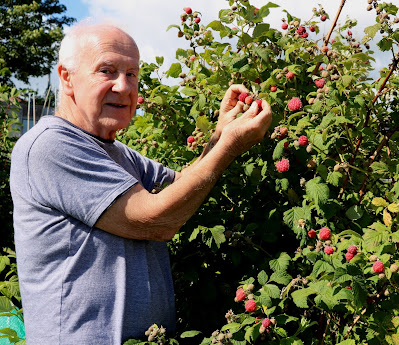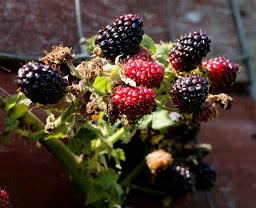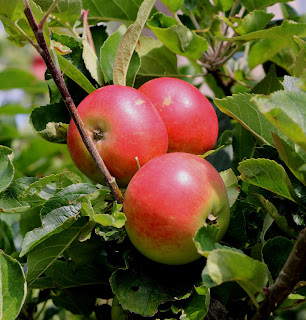LATE
SUMMER HARVEST
As
summer draws to a close, fruit and vegetables all start to ripen up
and harvesting gets into full swing. These are very busy times as it
is not just the picking, but also the sorting, cleaning, grading,
boxing, bagging, blanching as food is prepared for storing and
freezing. |
Anna picks a few beetroot
|
Sweet
corn Incredible had put on good growth and was a few days away from
harvest, when the gales arrived at the end of August and flattened
the crop, so the cobs got picked and bagged up. The old plants were
then pulled out, soil shook off then carried up to the compost heap
for chopping up with a shade to help them rot down. Back home the
cobs had to be stripped of leaves then graded for immediate use for
fridge storage and the rest blanched and bagged for the free |
Cabbage Kilaton
|
zer.
Dwarf
French beans had also been blown over so Anna picked a good crop, but
then once home they had to be topped, tailed, sorted and washed, then
bagged up for fridge and freezer.
Cabbage
Kilaton, Cauliflower Clapton and kale have all excelled this year so
a lot of crop had to be given away as Anna may have found plenty
excellent recipes, but two wee Scots folk can only eat so much.
Pumpkins are having their best year ever. I have four absolutely
massive pumpkins still growing, but as harvesting is still
traditionally a week before Halloween they could be a lot bigger.
Some pruning was carried out with  |
Potato Bambino
|
one side shoot fifteen feet long
heading towards the gate trying to escape. It got chopped as did the
shoots clambering through my gladioli and chrysanthemums, beans and
strawberries. Courgettes continue to offer plenty fruit, but as Anna
has perfected a great soup recipe and also a brilliant courgette
cake, we now only need to give away the occasional fruit.
This
growth year has been fantastic for salads. Lettuce, radish, spring
onions, beetroot and rocket have all grown very fast. I am now on my
fourth row of lettuce, sown on land recently cleared of broad beans,
and land getting cleared of potatoes will either get sown with winter
hardy lettuce and spring onions, or a green manure crop. Beetroot
have all grown a good size this year and the thinnings taken earlier
as baby beet were very welcome.
Under glass the tomatoes have
all cropped heavily, but large bowls of fresh cherry tomatoes in the
house are very easy to consume at every opportunity, and surplus
large Alicante tomatoes make a delicious soup. |
Muscat and Aronia wine brewing
|
Most fruit crops have also
joined in the growth bonanza, with loads of strawberries, raspberries
and brambles and now the autumn fruiting raspberry, Polka, although
flattened earlier by the gales has now recovered and cropping well
with exceptionally large and sweet berries. Then the fig bush, now a
small tree, joined in the party and it is quite easy to pick a dozen
ripe figs twice a week. All of this excess keeps us in good form as
we snack a few fresh fruits in between meals. No need to reach for
the biscuit tin, although Anna’s courgette cake is hard to resist.
Earlier red currants,
blackcurrants, gooseberries and Aronias, the chokeberry were all
picked, sorted, cleaned up and either went into the freezer or cooked
in batches of jam as long as I got my ten pounds of each for wine
brewing to give me three demijohns of each to put down for a few
years. Greenhouse grapes and the Aronias are all quietly bleeping
along in demijohns in the background as the yeast convert the sugars
into a wee bit of tasty alcohol.
Apple Discovery is now
ripe and ready for picking, but this year my pear crop has failed as
earlier gales tore off all the young fruits. Reckon we could get
about three pears each in autumn.
Wee
jobs to do this week
Tomatoes in the
greenhouse will now be in full cropping with the occasional glut
following any period
 |
Removing old leaves
|
of warm sunny weather. This can continue till
well into autumn provided you look after them. Once the cordons reach
the roof after about five to seven trusses the tops will have been
removed, but the plants will still try to keep growing so look out
for sideshoots hiding amongst the foliage and remove them and any
leaves showing signs of botrytis rot as it can spread. Keep giving
them a weekly feed and keep ventilators open as well as the door on
all sunny days.
END










































